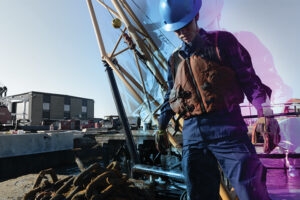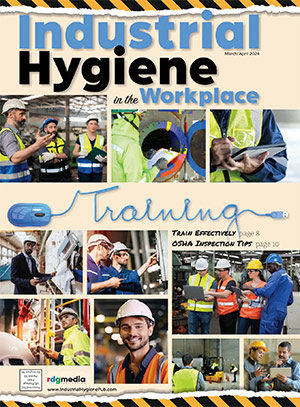Wearables in the Modern Workplace
By: Cheryl Palmer, Contributor
 Did you know helmets were once blamed for causing head injuries? Yet today, the thought of setting foot on a work site without a hard hat is unheard of. Low-tech PPE, such as hard hats, steel-toed boots and high-visibility clothing may sound like obvious safety requirements in 2022, but they were once novel technologies. They were questioned and scrutinized the same way businesses question high-tech options today. There will be a time when people look back and question the sanity of those of us who worked in high-risk environments without worker-centric technology.
Did you know helmets were once blamed for causing head injuries? Yet today, the thought of setting foot on a work site without a hard hat is unheard of. Low-tech PPE, such as hard hats, steel-toed boots and high-visibility clothing may sound like obvious safety requirements in 2022, but they were once novel technologies. They were questioned and scrutinized the same way businesses question high-tech options today. There will be a time when people look back and question the sanity of those of us who worked in high-risk environments without worker-centric technology.
As consumers, we are already using high-tech solutions for our most challenging problems and to make our lives easier. One example is technology that monitors our health and wellbeing—from sleep technology to smart watches and apps on mobile phones. Now, consumer technology used by large groups of people is becoming specialized for use in industrial applications.
Since 2015, survey results indicate a consistent 73% of workers are willing to use wearable technology at work if it improves safety. 81% of CIOs believe high-tech wearable technology will become common in the workplace. Despite these numbers, only about 12% of workers report using wearable technology on the job.
Emerging Wearable Technology to Consider
Artificial Intelligence (AI), machine learning and automation are buzzwords that guide our decisions on ways to benefit from technology. Numerous companies are focused on increasing worker safety or productivity through developing connected worker technologies. These technologies fall into several wearable categories.
Accessory Devices

Using wearable technology to connect workers for the purpose of understanding the “what, how and why” of worker injuries is imperative to advancing safety, productivity and workers’ health and wellbeing. (photo courtesy Kenzen)
High-tech watches and fitness trackers have been part of our day-to-day lives for several years. Currently, their most common use in the workplace is related to healthcare incentives that track employee behaviors and gather data used to lower insurance premiums. They’re also often credited with assisting in time-management and boosting productivity. Major wearable watch companies have also been researching how to develop illness-detection capabilities. Many viruses are communicable before a person knows they are sick, so illness-detection could increase workplace health and safety by informing employees they are ill and encouraging them to stay home—so they do not spread the illness within their workplace.
Other companies are exploring and developing uses for wearable devices that may increase worker safety, such as fall detection, posture monitoring, GPS positioning and core body-temperature monitoring. These applications are not part of existing consumer-brand smartwatches and are generally used for a very specific purpose and dataset. These capabilities will likely be developed and merged into one device in the future.
Smart Clothing
Wearable technology won’t be confined to accessory devices for much longer. Smart textiles have become a focus for several major companies and universities. PPE-type clothing, such as cut-proof sleeves, arc-proof clothing and slip-resistant surfaces, are existing wearable tech solutions. PPE clothing will become smarter—capable of monitoring employees’ heart rate, breathing and posture. Clothing will also be able to monitor environmental hazards, such as UV exposure, temperature and air quality. Many companies will collect this data from the clothing and connect it to an app that offers safety insights and suggestions for improving performance.
Exoskeletons
Ironman-type suits that reduce risk to the human body are still a vision of the future. Exoskeleton development dates back to the 1960s, but products didn’t come to market as viable solutions until the 21st century. The first exoskeleton prototypes were for gait training for people with stroke and spinal cord injuries.
Since 2014, several companies have designed exoskeletons to protect workers. They are designed to reduce muscle fatigue and prevent injury when lifting, bending, reaching, squatting and performing other repetitive or heavy-lifting activities. This wearable technology generally works by improving posture and redistributing weight. The capabilities of this technology and its workplace applications are still being discovered and researched.
Glasses

Smart clothing will be able to monitor environmental hazards, such as UV exposure, temperature and air quality. (photo courtesy Kenzen)
The first piece of wearable technology ever created was the eye glass. Eyeglasses with futuristic capabilities are still in prototype and secondary development stages. Tech innovators are only skimming the surface of how glass technologies may be used for worksite enhancements. Current smart glasses offer a wide range of features and price tags. Simple, cheaper versions have the characteristics of a smart watch. Some act simply as a platform for viewing things. Eyeglasses can take calls, deliver notifications and allow the wearer to control music through a touch interface. Some eye technology can even take pictures and apply filters to the pictures.
Other higher-tech eyewear solutions were designed to supplement the brain’s ability to memorize complex diagrams and processes. These glasses allow the user to view displays from their phone or computer while working. Some even integrate with virtual meeting platforms, allowing workers to consult supervisors or share live work experiences.
At the more complex and expensive end of smart glasses, big brand names and start-ups alike are experimenting with augmented reality (AR) solutions. They can overlay images on a real-world, real-time view. Not surprisingly, versions that currently exist are only available for specific work applications. Glass technologies that include VR or AR options are being used to reduce time and costs for training. They can also be used to experiment with various approaches and techniques to view the most favorable approach and outcome, i.e., for use in complex medical surgeries.
Smart glasses can even be used to assess an individual’s job skills. AR smart glass solutions are now available for healthcare, manufacturing, education and national defense applications. While smart eyewear is currently cost-prohibitive for many employers, this category of smartwear is projected to double in value in as little as three years, with increased capabilities at decreased costs.
Considerations Before Implementing High-Tech Wearables
With the exception of smart eyewear, most industrial wearable options are affordable. Ready to give the majority of workers what they want when it comes to wearables? Here are considerations and next steps:
Do it for the Right Reason: Focus on Safety
Bring high-tech wearables into your workplace for the primary purpose of increasing worker safety. Increase user adoption and success rates by choosing solutions that empower and enable employees to make good choices about their health and wellness.
Understand Data Privacy

Increase user adoption and success rates of high-tech wearables by choosing solutions that empower and enable employees to make good choices about their health and wellness. (photo courtesy Kenzen)
You can avoid being seen as a “Big Brother” by giving employees access to their data and educating them on how to use it to make informed decisions. Always use informed consent by being transparent about the data that is collected (or not collected); who can see the data; and how the data will be used.
Educate yourself about the type of data the technology collects. Know whether the device collects biometric (identifiable) or physiological (not identifiable) data and learn the difference between the two. Understanding the data that is collected and the purpose for that data can help you identify privacy risks vs. data benefits. Data knowledge allows you to provide employees with transparent information and accurate training regarding the technology.
Correct data handling and storage is vital, no matter what type of data a wearable collects. Let your IT team do its due diligence on the technology you are considering. Have them research the technology vendor’s security and privacy policies. Ensure the security and privacy policies adhere to local or regional regulations. Require vendors to meet security standards (SOC2, ISO27001, GDPR, etc.) before bringing their technology into your company. Be open and transparent with your employees regarding the findings of your privacy and security investigations. Create FAQ documents that explain what data is collected, who owns it, how it is stored and how it is used. Explain how an employee can request access to their data or have it deidentified.
Know the Science Behind the Tech
Consider whether the technology vendor provides evidence-based research, proving their device is capable of doing what they claim it does. Conducting partnered research with reputable universities and publishing peer-reviewed articles are good signs the vendor is able to deliver exactly what it promises. Don’t be afraid to ask for reasoning and research to guide your decisions, especially when it relates to worker physiology. Even if you don’t fully understand physiological science, you should be capable of judging whether the company has solid, scientifically backed methods or formulas for their solutions.
Organize a pilot project at one of your worksites to gather your own use-case information to ensure the device will meet your needs and perform as expected. Determine whether the company is willing and able to adjust their product and services to meet the specific needs of your industry and company.
Understand the Return Before You Invest
Prepare and analyze some return on investment (ROI) scenarios. Start with simple, straightforward equations that balance the cost of the technology vs. the number of injuries you can expect to prevent. Consider the increase in productivity because of improved health and wellness, and add this number into your ROI calculation. Finally, calculate other metrics impacted by the technology and build them into your ROI. For example, you may find a technology that monitors core body temperature increases the productivity of certain safety professionals, such as your nursing or safety staff. You may also see a reduction in slips, trips, falls and machinery accidents when workers receive alerts to rest and cool down before the impacts of heat illness affect them. Thinking beyond the initial benefits of the technology and using data gathered from your pilot project can help you build out strong, more accurate ROI scenarios.
Connected technology is defining what many call the Fourth Industrial Revolution. Using wearable technology to connect workers for the purpose of understanding the “what, how and why” of worker injuries is imperative to advancing safety, productivity and the health and wellbeing of everyone on the job.
Cheryl Lynn Palmer is Customer Success Manager with Kenzen. She works with companies globally that use wearable technology to predict and prevent worker injuries and fatalities caused by heat.
Share on Socials!
Hazard Training: Safety Data Must Be 24/7
What to Expect from OSHA in 2023: Personnel and Policy Changes
IIoT in Gas Detection: Bridging Gaps with Technology to Stay Connected
Leaders in Industrial Hygiene
Council for Accreditation in Occupational Hearing Conservation (CAOHC)
Subscribe!
Sign up to receive our industry publications for FREE!









